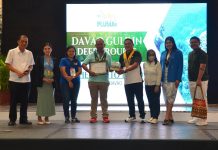By Greg G. Deligero
The word patent may sound strange for one unlearned in the law, exclusive only to inventors,
scientists and intellectuals.
But in a knowledge-based economy, intellectual property is becoming an important tool not only for the academe but for the government and commercial entities and industry players.
A patent is a set of exclusive rights granted for an invention, which is a product or a process that provides, in general, a new way of doing something or offers a new technical solution to a problem. Patents are a form of intellectual property granted in a “first-to-file rule.”
According to Dr. Romel V. Gador, manager of the Innovation and Technology Support Office (ITSO) at the University of Southeastern Philippines (USeP), 80 percent of the market value of the Fortune Top 500 companies is intangible assets like patents, trademarks and brand.
He said that the values of intellectual assets include trademarks for name and logo, patents for technologies, design patents for aesthetics, copyrights for software and trade dress for overall look.
But in the Philippines, Gador said that of the roughly 1,000 patent filings, 90 percent are filed by foreign entities less than five percent are filed by local individuals and research institutions.
The country also lagged behind its neighboring East Asian countries in terms of patent applications per million population, government procurement of advanced technological products, university-industry collaboration, national office utility model applications and national office trademark registrations.
China is the worldwide leader in patent applications in the field of marine energy, hydro power, biomas energy, hybrid vehicles, heating, methane gas and insulation.
“From 2000 to 2010, the annual research publications in the country increased by 250 percent but patent filings by Philippine institutions both public and private did not change much. In short, the number of research was increasing but with flat patent filings,” he said.
“The Philippines is home to a creative and innovative people but there is a failure to capture and exploit their inventions,” he added.
It is the main reason why the Intellectual Property Office of the Philippines (IPOPHL) established 60 ITSOs nationwide in 2011. There are only three ITSOs in Mindanao: USeP, the Mindanao State University-Iligan Institute of Technology (MSU-IIT) and the Caraga State University.
As manager of ITSO in Davao Region, Gador said he is now strengthening the establishment of Southern Mindanao ITSO Network composed of academic institutions, government agencies, private companies, civic and non-government organizations.
Gador has been in the College of Technology of USeP as a faculty since 1996, helping clients acquire necessary knowledge, skills and work values, which are necessary for an effective manpower in southern part of Mindanao. He is currently the dean of technology unit of the university.
He completed his PhD major in Technology Manangement in 2010 at the Technological University off the Pjhilippines, Manila and has been registered as patent agent by the European Patent Office and the Intellectual Property Office of the Philippines (IPOPHL) in 2011.Gador said the ITSO will serve as a patent research facility and library for patent information, provide skills training in patent searching, patent drafting and prosecution, provide intellectual property management and commercialization strategies, serve as depository of patent-related documents and organize a community of patent information users and experts.
“We will facilitate access to global science and technology information, promote domestic and globally-recognized innovations and assist in the commercialization of globally-competitive innovations,” he said.
Gador said ITSO has access 75 million patent documents worldwide in varied fields of technology, adding that worldwide, there are nearly two million patent applications filed every year and over 700,000 new science and engineering articles published each year.
“These are mountains of potentially relevant data,” he said.
With the voluminous documents, Gador said the ITSO will help the patent applicants in setting the limitations on searched data, search parameters and evaluation parameters.
“There should be limitations as to what are related to inventions of patent application because the more documents are retrieved, more documents to be reviewed and more time required,” he said.
0 Comments
Oldest






